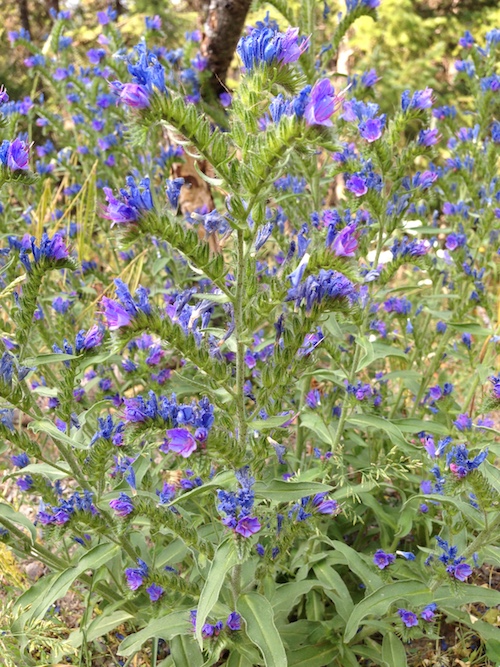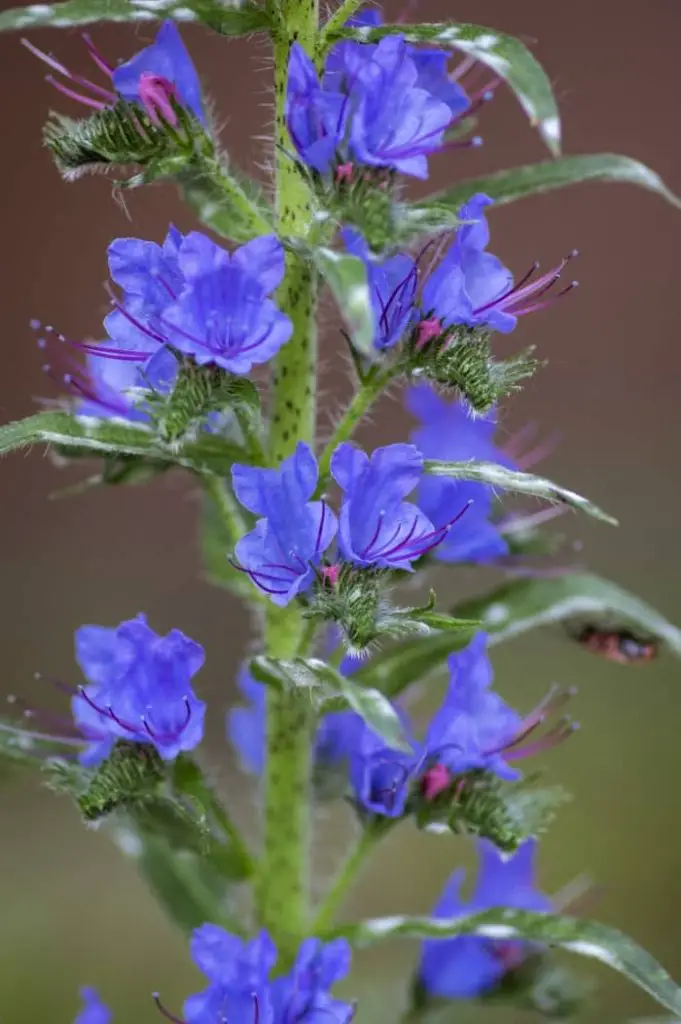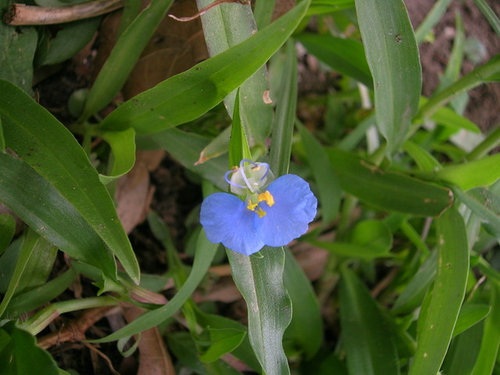The Uninvited Guests: Understanding Invasive Weeds
Invasive weeds are a significant threat to gardens, ecosystems, and local biodiversity. These non-native plant species outcompete native vegetation, alter ecosystem processes, and affect the delicate balance of nature. Invasive weeds with blue flowers, in particular, can be especially problematic due to their ability to produce large quantities of seeds, which can be dispersed by wind, water, or human activity. Examples of common invasive weeds with blue flowers include Blue Devil, Blueweed, and Cornflower, which can thrive in a variety of environments and are often difficult to eradicate. Understanding the nature and impact of invasive weeds is crucial for effective management and control. By recognizing the signs of invasive weeds and taking prompt action, gardeners and land managers can prevent the spread of these noxious plants and protect the integrity of their ecosystems.
How to Recognize Invasive Weeds with Blue Flowers
Identifying invasive weeds with blue flowers can be a challenging task, especially for those without a botanical background. However, recognizing these noxious plants is crucial for effective management and control. Invasive weeds with blue flowers often exhibit distinct characteristics that set them apart from native species. For instance, Blue Devil (Echium vulgare) can grow up to 3 feet tall, with a rosette of leaves and a tall, erect stem bearing blue, tubular flowers. Blueweed (Echium plantagineum), on the other hand, has a more sprawling habit, with a profusion of blue flowers borne on long, slender stems. Cornflower (Centaurea cyanus) is another common invasive weed with blue flowers, characterized by its bright blue blooms and prickly, thistle-like foliage. By familiarizing themselves with the growth habits, leaf shapes, and flower colors of these invasive weeds, gardeners and land managers can take the first step towards controlling their spread and protecting native ecosystems.
The Most Common Invasive Weeds with Blue Flowers
Several invasive weeds with blue flowers have been identified as significant threats to native ecosystems and biodiversity. These noxious plants can outcompete native species, alter ecosystem processes, and affect local ecosystems. Here are some of the most common invasive weeds with blue flowers:
Blue Devil (Echium vulgare) is a biennial weed native to Europe and Asia, but has been naturalized in many parts of North America. It can grow up to 3 feet tall, with a rosette of leaves and a tall, erect stem bearing blue, tubular flowers. Blue Devil thrives in disturbed areas, roadsides, and open fields, and can spread rapidly through seed dispersal.
Blueweed (Echium plantagineum) is another invasive weed with blue flowers, characterized by its sprawling habit and profusion of blue flowers borne on long, slender stems. Native to the Mediterranean region, Blueweed has been introduced to North America and has become a significant problem in many areas. It can grow in a variety of habitats, including grasslands, open woods, and along streams.
Cornflower (Centaurea cyanus) is an annual weed with bright blue flowers, native to Europe and Asia. It has been introduced to North America as an ornamental plant, but has escaped cultivation and become a noxious weed in many areas. Cornflower can grow up to 3 feet tall, with a slender stem and a terminal cluster of blue flowers. It thrives in disturbed areas, roadsides, and open fields, and can spread rapidly through seed dispersal.
These invasive weeds with blue flowers can have significant environmental and economic impacts, including the displacement of native species, alteration of ecosystem processes, and reduction of agricultural productivity. By understanding the characteristics, origins, and spread patterns of these noxious plants, gardeners and land managers can take effective action to prevent their spread and protect native ecosystems.
The Impact of Invasive Weeds on Local Ecosystems
Invasive weeds with blue flowers can have devastating environmental and economic impacts on local ecosystems. These noxious plants can outcompete native species for resources such as water, light, and nutrients, leading to a decline in native plant populations and a loss of biodiversity. Invasive weeds with blue flowers can also alter ecosystem processes, such as nutrient cycling and fire regimes, which can have cascading effects on entire ecosystems.
One of the most significant environmental impacts of invasive weeds with blue flowers is their effect on water quality. These plants can increase sedimentation, reduce water flow, and alter the chemistry of water bodies, making them unsuitable for native aquatic species. For example, Blue Devil (Echium vulgare) can grow in dense stands along streams and rivers, reducing water flow and increasing sedimentation.
In addition to environmental impacts, invasive weeds with blue flowers can also have significant economic impacts. These plants can reduce agricultural productivity by competing with crops for resources, and can also increase the cost of land management and maintenance. For example, Cornflower (Centaurea cyanus) can infest agricultural fields, reducing crop yields and increasing the cost of herbicide application and manual removal.
Furthermore, invasive weeds with blue flowers can also have social impacts on local communities. These plants can reduce the aesthetic value of natural areas, making them less desirable for recreation and tourism. They can also reduce the cultural significance of native plants, which may be important for indigenous communities.
Overall, the impacts of invasive weeds with blue flowers on local ecosystems can be far-reaching and devastating. It is essential to take action to prevent the spread of these noxious plants and to manage their populations effectively. By understanding the environmental, economic, and social impacts of invasive weeds with blue flowers, gardeners and land managers can take a proactive approach to protecting native ecosystems and preserving biodiversity.
Effective Methods for Controlling Invasive Weeds
Controlling invasive weeds with blue flowers requires a combination of effective methods and a long-term management strategy. Here are some of the most effective methods for controlling invasive weeds with blue flowers:
Physical removal is a simple and effective method for controlling invasive weeds with blue flowers. This involves manually pulling or digging up the weeds, making sure to remove as much of the root system as possible to prevent regrowth. Physical removal is most effective for small infestations and can be done by hand or with the help of tools such as shovels and weed wrenches.
Herbicides are another effective method for controlling invasive weeds with blue flowers. Selective herbicides can be used to target specific weeds, while non-selective herbicides can be used to clear large areas of weeds. However, herbicides can have negative environmental impacts and should be used with caution. It’s essential to follow the label instructions and take necessary precautions to avoid overspray or drift onto non-target plants.
Biological control involves using natural enemies of invasive weeds with blue flowers to control their populations. This can include insects, diseases, or other organisms that specifically target the invasive weed. Biological control is a long-term strategy that requires careful planning and monitoring, but can be an effective and environmentally friendly method for controlling invasive weeds.
Integrated pest management (IPM) is a holistic approach that combines physical removal, herbicides, and biological control to manage invasive weeds with blue flowers. IPM involves identifying the most effective methods for controlling the weed, and using a combination of these methods to achieve the best results. IPM also involves monitoring the weed population and adjusting the management strategy as needed.
It’s essential to note that controlling invasive weeds with blue flowers is an ongoing process that requires regular monitoring and maintenance. It’s also important to prevent the spread of invasive weeds by cleaning equipment, avoiding contaminated soil, and monitoring for early detection. By using a combination of effective methods and a long-term management strategy, it’s possible to control invasive weeds with blue flowers and protect native ecosystems.
Preventing the Spread of Invasive Weeds
Preventing the spread of invasive weeds with blue flowers is crucial to protecting native ecosystems and preventing their harmful impacts. Here are some tips and strategies for preventing the spread of invasive weeds with blue flowers:
Cleaning equipment is essential to preventing the spread of invasive weeds with blue flowers. Make sure to clean all equipment, including mowers, trimmers, and tools, after use to prevent the spread of seeds and plant fragments. Use a mixture of soap and water to clean equipment, and dry thoroughly to prevent the spread of invasive weeds.
Avoiding contaminated soil is another key strategy for preventing the spread of invasive weeds with blue flowers. When purchasing soil or plants, make sure to check for any signs of invasive weeds. Avoid using soil or plants that have been contaminated with invasive weeds, as this can spread the problem to new areas.
Monitoring for early detection is critical to preventing the spread of invasive weeds with blue flowers. Regularly monitor your garden or landscape for signs of invasive weeds, and take action immediately if you detect any. Early detection and removal can prevent the spread of invasive weeds and reduce their impacts.
Other strategies for preventing the spread of invasive weeds with blue flowers include:
- Using weed barriers to prevent seed germination and plant growth
- Implementing a “clean, drain, and dry” protocol for boats and other watercraft to prevent the spread of aquatic invasive weeds
- Avoiding the intentional introduction of invasive weeds with blue flowers, such as through plant sales or trade
- Participating in local invasive weed management efforts and education programs
By following these tips and strategies, you can help prevent the spread of invasive weeds with blue flowers and protect native ecosystems. Remember, preventing the spread of invasive weeds is an ongoing process that requires regular monitoring and maintenance.
Alternative Native Plants with Blue Flowers
While invasive weeds with blue flowers can be a nuisance, there are many beautiful and beneficial native plants with blue flowers that can be used as alternatives. These native plants not only provide a similar aesthetic appeal but also support local ecosystems and biodiversity. Here are some examples of native plants with blue flowers that can be used as alternatives to invasive weeds:
Bluebells (Hyacinthoides spp.) are a popular native plant with blue flowers that can be used to add color and beauty to gardens and landscapes. They are low-maintenance, deer-resistant, and attract pollinators. Bluebells are also an excellent choice for woodland gardens and shady areas.
Forget-me-nots (Myosotis spp.) are another native plant with blue flowers that can be used as an alternative to invasive weeds. They are easy to grow, require minimal maintenance, and attract butterflies and hummingbirds. Forget-me-nots are also an excellent choice for containers and hanging baskets.
Blue wild indigo (Baptisia australis) is a native legume with blue flowers that can be used as a nitrogen-fixing alternative to invasive weeds. It is a low-maintenance plant that attracts pollinators and provides a natural source of fertilizer for the soil.
Other native plants with blue flowers that can be used as alternatives to invasive weeds include:
- Blue phlox (Phlox divaricata)
- Bluebottle (Centaurium erythraea)
- Blue-eyed Mary (Collinsia grandiflora)
When selecting native plants with blue flowers, make sure to choose plants that are suitable for your local climate and soil conditions. Also, be sure to purchase plants from reputable nurseries or suppliers to ensure that they are free of invasive weeds and diseases.
By using native plants with blue flowers as alternatives to invasive weeds, you can create a beautiful and sustainable garden or landscape that supports local ecosystems and biodiversity. Remember, every small action counts in the fight against invasive weeds with blue flowers.
Conclusion: Taking Action Against Invasive Weeds
Invasive weeds with blue flowers can have devastating effects on local ecosystems and biodiversity. However, by understanding the characteristics, impacts, and control methods of these weeds, individuals can take action to prevent their spread and promote the growth of native plants. It is essential to recognize the importance of identifying and managing invasive weeds with blue flowers in gardens and communities.
By implementing the strategies outlined in this article, individuals can make a significant difference in the fight against invasive weeds with blue flowers. From recognizing the signs of invasive weeds to using alternative native plants, every action counts. Remember, invasive weeds with blue flowers are a collective problem that requires a collective solution.
Take the first step today by assessing your garden or landscape for signs of invasive weeds with blue flowers. Remove any invasive weeds, and replace them with native plants that support local ecosystems. Educate your friends, family, and community members about the importance of managing invasive weeds with blue flowers.
Together, we can create a future where native plants thrive, and invasive weeds with blue flowers are a thing of the past. The time to act is now. Take action against invasive weeds with blue flowers and make a positive impact on your local environment.







